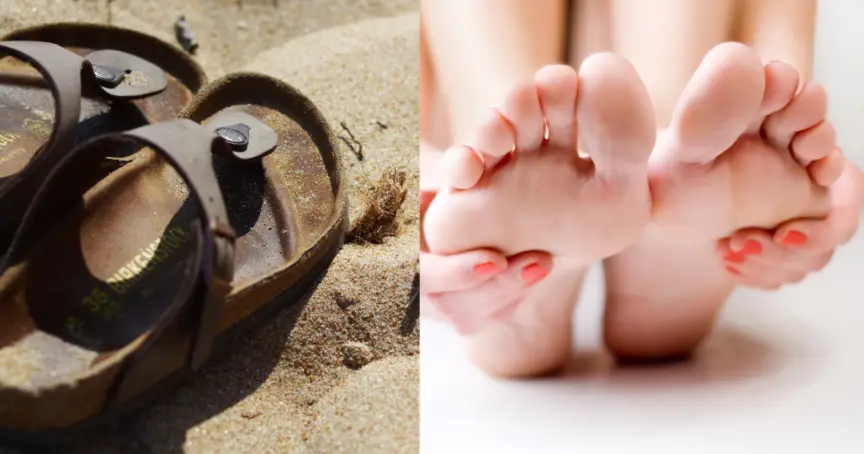ShoesandFitness.com is supported by our readers. We may earn a commission when you purchase through links on this page. Our content is checked for factual accuracy by our editorial team before being published.
Flat feet, a common condition affecting millions, can make finding comfortable and supportive footwear feel like a quest for the Holy Grail. Enter Birkenstocks: a stylish and comfy solution that has been a household name for decades. In this article, I’ll explore the relationship between Birkenstocks and flat feet, discussing how these iconic sandals may provide relief and improve overall foot health. But first, let’s dive into the world of flat feet to better understand this prevalent condition. So, Are Birkenstocks good for flat feet?
Understanding Flat Feet
Flat feet, or fallen arches, occur when the arch of the foot collapses, causing the entire sole to make contact with the ground. There are two primary types of flat feet: flexible and rigid. Flexible flat feet can develop an arch when not bearing weight, while rigid flat feet maintain their flatness even without weight-bearing.
Common causes of flat feet include genetics, aging, obesity, and injury. Symptoms may vary, but individuals with flat feet often experience pain, swelling, and difficulty in finding supportive footwear.
The Birkenstock Design
Birkenstock, a German brand with a rich history dating back to 1774, is synonymous with comfort and style. Their signature contoured cork footbed sets them apart from other footwear. This footbed, made from a blend of cork, latex, and jute, adapts to the wearer’s foot shape over time, providing customized support.
Additionally, Birkenstock sandals feature adjustable straps, which ensure a secure fit. The EVA sole offers shock absorption and durability, further enhancing the overall comfort of the shoe.
Birkenstocks and Flat Feet: A Beneficial Relationship
For those with flat feet, Birkenstocks can provide relief from common symptoms. The contoured footbed delivers crucial arch support, while the deep heel cup helps distribute body weight evenly, reducing pressure on the feet.
Wearing Birkenstocks can lead to improved posture, reduced pain, and increased overall comfort for individuals with flat feet. Furthermore, the adjustable straps allow for a personalized fit, accommodating various foot shapes and widths.
What makes Birkenstocks a good option for individuals with flat feet?
Birkenstocks are a good option for individuals with flat feet because they offer a contoured footbed for arch support, adjustable straps for a personalized fit, and a deep heel cup for even weight distribution. These features help to reduce pain and discomfort associated with flat feet.
Are Birkenstock sandals suitable for people with flat feet?
Yes, Birkenstock sandals are suitable for people with flat feet. Their contoured cork footbed provides essential arch support, and the deep heel cup aids in distributing body weight evenly, helping to alleviate common symptoms associated with flat feet.
Do Birkenstocks cure flat feet?
Birkenstocks do not cure flat feet, but they can provide relief and support for individuals with this condition. Wearing Birkenstocks can help alleviate pain, improve posture, and offer a comfortable footwear option for those with flat feet.
Can wearing Birkenstocks improve flat feet symptoms?
Yes, wearing Birkenstocks can improve flat feet symptoms. The contoured footbed, deep heel cup, and adjustable straps work together to provide arch support, proper weight distribution, and a comfortable fit, which can help alleviate pain and discomfort associated with flat feet.
Choosing the Right Birkenstock for Flat Feet
To choose the right Birkenstock model for flat feet, consider factors such as the width (available in regular or narrow) and the type of footbed (soft or classic). Measure your feet or consult a sizing chart to find the best fit. Additionally, select a model with adjustable straps to accommodate different foot shapes and widths. It’s also important to be patient when breaking in your Birkenstocks, as the footbed will gradually adapt to your foot’s unique shape for optimal comfort.
The Two Types of Birkenstock Footbeds and Flat Feet
Birkenstock is known for its unique, comfortable footbeds that offer support and relief to various foot conditions, including flat feet. There are two main types of Birkenstock footbeds: the Regular Footbed and the Soft Footbed. Let’s take a closer look at each type and how they cater to flat feet.
Regular Footbed
The Regular Footbed, also known as the Original Footbed, is the foundation of Birkenstock’s comfort and support. It features a contoured cork-latex construction that molds to the wearer’s foot shape over time. The Classic Footbed provides excellent arch support, a deep heel cup for stability, and a raised toe bar to promote the natural gripping motion of the foot.
For individuals with flat feet, the Classic Footbed’s arch support can help alleviate pain and discomfort by redistributing weight and pressure evenly across the foot. Additionally, the deep heel cup aids in maintaining proper foot alignment, which can be beneficial for those with flat feet.
Soft Footbed
The Soft Footbed, introduced in the late 1990s, is an adaptation of the Classic Footbed with an added layer of cushioning. This cushioning is made of soft, resilient foam that sits between the cork-latex footbed and the suede liner, providing extra padding for a more comfortable feel.
While the Soft Footbed maintains the same basic structure and support features as the Classic Footbed, it offers an even greater level of comfort for those with flat feet. The extra cushioning can help absorb shock, reducing the impact on the feet and joints while walking or standing.
Choosing Between the Regular and Soft Footbeds for Flat Feet
When deciding between the Regular and Soft Footbeds for flat feet, consider your personal preference for cushioning and support. The Regular Footbed provides firm support and a more traditional Birkenstock feel, while the Soft Footbed offers additional cushioning for a softer, more forgiving experience.
Both footbed types can accommodate flat feet, but individuals with sensitive feet or a preference for extra cushioning may prefer the Soft Footbed. It is essential to try on both types to determine which one feels most comfortable and supportive for your specific needs. Remember, proper fit and break-in time are crucial for achieving optimal comfort with Birkenstock sandals.
Discover Some Great Birkenstock Alternatives
Alternative Footwear Options for Flat Feet
While Birkenstocks are a popular choice for flat feet, other footwear options may also provide adequate support and comfort. These alternatives include athletic shoes with arch support, orthotic inserts, and custom-made footwear. When comparing these options, consider factors such as support, comfort, and price to determine the best fit for your needs.
Musculoskeletal Problems that Flat Feet Cause
Flat feet, also known as fallen arches or pes planus, can lead to various musculoskeletal problems. When the arches of the feet collapse, it alters the natural alignment and biomechanics of the lower extremities, which may subsequently affect other parts of the body. Here are some common musculoskeletal problems associated with flat feet:
- Plantar fasciitis: Flat feet can put excessive stress on the plantar fascia, a thick band of tissue running along the bottom of the foot. This may result in inflammation and pain in the heel and arch areas.
- Achilles tendonitis: The Achilles tendon connects the calf muscles to the heel bone. Flat feet can place additional strain on this tendon, leading to inflammation and pain.
- Shin splints: Flat feet can contribute to improper distribution of weight and shock absorption while walking or running. This may cause pain and inflammation in the lower leg muscles and connective tissues, commonly known as shin splints.
- Knee pain: The misalignment caused by flat feet can put undue stress on the knee joint, leading to pain and potential long-term damage.
- Hip pain: Flat feet can also affect the alignment of the hips, causing pain and discomfort in the hip joints and surrounding muscles.
- Lower back pain: The altered biomechanics associated with flat feet can lead to an imbalanced distribution of weight and stress on the lower back, resulting in pain and discomfort.
- Posture problems: Flat feet can impact overall body posture, leading to imbalances and compensations that can affect the spine, shoulders, and neck.
It is essential for individuals with flat feet to seek proper footwear, orthotics, or other supportive measures to help alleviate these potential musculoskeletal issues. Consulting a podiatrist, physical therapist, or orthopedic specialist can provide further guidance on managing flat feet and preventing related problems.
Conclusion
In summary, Birkenstock sandals can be a game-changer for individuals with flat feet. Offering arch support, even weight distribution, and personalized fit, these stylish sandals can help alleviate common symptoms and improve overall foot health. If you have flat feet and are in search of comfortable and supportive footwear, don’t hesitate to give Birkenstocks a try. So, step into a pair and let your feet experience the unparalleled comfort they deserve!






